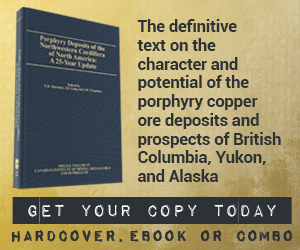Library Magazine Articles Standards for Qualified Persons: how to evaluate relevant experience
Standards for Qualified Persons: how to evaluate relevant experience
Craig Waldie & Jim Whyte - Jun 2012
With the increased number of unique and novel mineral deposit types and environments currently being explored and developed, it has reportedly become difficult for mining companies to identify a Qualified Person (QP) who has the relevant experience and competencies necessary to assess and provide a defendable opinion on a particular mineral project. In order to be considered a QP for a specific project, the individual must have a certain level of education, accountability and relevant experience. While determining whether the education and accountability requirements are met is usually straightforward, evaluating whether an individual has the required amount of relevant experience is more complicated.
An accurate self-assessment of a QP’s relevant experience is important; the QP plays a critical role in ensuring industry standards and best practices are followed, and data is verified and suitable for public disclosure. In other words, it is the QP’s responsibility to determine what is reasonable, appropriate and ethical for a particular situation and circumstance.
So, what is relevant experience and how is it evaluated? Common sense helps. Relevant experience could mean transferable experience that may reasonably be applied to another mineral or commodity, deposit type or style, situation, or environment. It is up to the judgement and confidence of the QP to determine whether or not his or her experience qualifies as relevant experience; it should be noted, however, that a regulator may challenge the QP’s evaluation.
It is essential that QPs assess their own experience because, as mineral deposits are diverse in style and are found in a wide variety of settings, and the stage of development of a particular project is key to understanding which tasks are critical and what experience is relevant, there are too many variables to be taken into account for regulators to set specific technical standards. To assist QPs in assessing relevant experience, CIM Definition Standards on Mineral Resources and Mineral Reserves provides guidance, stating: “The Qualified Person should be clearly satisfied that they could face their peers and demonstrate competence and relevant experience in the commodity, type of deposit and situation under consideration.”
With the recent significant interest in exploration for rare earth minerals used for green-technology applications, it may be difficult to find professionals that have, for example, five years of experience in saprolite weathered carbonatite-hosted phosphate deposits with associated rare earth minerals.
Professionals with experience relevant to the environment, style of mineralization and considerations unique to these deposits may, depending on the facts and circumstances, feel confident acting as a QP.
As noted in the March/April 2012 CIM Magazine Standards column, the number of professionals with specific experience related to lithium and potassium mineral brine projects is limited, but it may be possible for certain professional hydrogeologists, using their educated and experienced judgment, to feel qualified and competent opining on such a project and environment.
It is also important to recognize that, unlike other jurisdictions where professional sign-off of public disclosure is limited to exploration results, and mineral resource and mineral reserve estimates, QPs are required to take responsibility for all scientific and technical information related to the minerals industry. In addition to exploration results and resource and reserve estimates, this information includes, but is not limited to, engineering studies and production targets, capital and operating costs, mining and processing activities, project infrastructure, and economic studies and analysis. Therefore, relevant experience in designing and engineering open pit mines in certain climatic environments, for example, may in some cases be more relevant than a significant amount of experience with the same deposit type as the project in question, but in a very different climatic region.
Regardless of the situation, the QP must understand they are taking responsibility for the publicly disclosed technical information of the project. If there are concerns about the QP’s professional judgment, technical report, statement, or opinion, the QP may face disciplinary action by his or her professional association, as well as possible civil liability risks for any misrepresentation. It is reported that the best defence against such claims is for the QP to ensure he or she conducts a reasonable investigation and level of verification for the particular circumstance under consideration, based on their professional ethics and standards, industry best practices and guidelines, applicable laws and regulations, and of course, relevant experience.
The views expressed in this article are those of the authors and do not necessarily represent the views of the Ontario Securities Commission.
Authors
Craig Waldie and Jim Whyte are both senior geologists with the Ontario Securities Commission, and are responsible for NI 43-101 compliance reviews of prospectuses, technical reports and other regulatory filings of Ontario-based mining companies.

.png)
